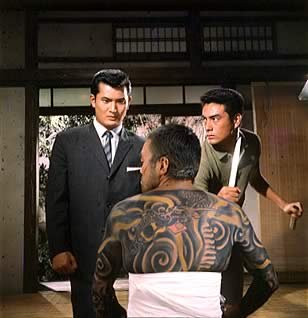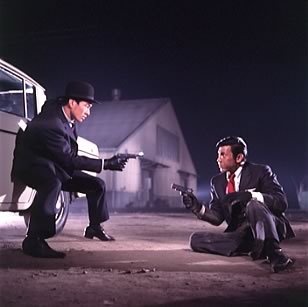Japanese Cult Cinema
Recently, I've discovered a gem in this city. And that gem being utterly Spanish, means that it's, by definition, truly bizarre. It's called La enana marrón (The Brown Midget) and it's a local theatre right in my neighborhood, resembling a strange cross-section between someone's living room (sofabeds included) and a dark back alley peepshow (projector and curtains included, beer for a small fee). Each month the owner gets independent films, shorts, experimental videoart, and cult films, which he later organizes into viewings based around themes. So, this month's "theme" has been Japan. The kick-off started with Sadao Yamanaka's 1935 "Tange-Sazen: A pot worth a million ryo", a film that is truly worthy of more attention, if for no other reason than the fact that it's a black and white samuri comedy (?), featuring the unforgettable protagonist Tange Sazen, a one armed, somewhat cross-eyed all powerful samuri, who hates music, but in the end has a soft spot for children. Weird, but good.
After getting sucked into the Brown Midget's enternally strange yet compelling "hole" (Collin, don't be jealous now), I returned the next few nights for the promise of some killer action-packed Japanese mobster films. I was anything but disappointed, and must say that for a short while now, Seijun Suzuki (photo above) has become my hero. The first Suzuki feature was "Oretachi No Chi Ga Yurusanai" (1964), and was translated into English as "Call of the Blood", which I later discovered to be a somewhat poor translation according to scholars, who opt for either "Our Blood Will Not Forgive" or simply "Blood Will Not Forgive" (Nicholas, feel free to correct this, if it's way off). Needless-to-say, there was a lot of blood and no forgiveness, mixed with some brotherly rivalry, a very tattooed samuri dude, some strange occidental vs. oriental tensions, and possibly the longest shoot-out/running/death scene I think I've ever seen. But, of course, it's amazing!
The stakes were set fairly high, given Suzuki's masterful camera techniques, often including quick, disorienting shifts between extreme long shots and "fetish-style" close-ups, not to mention his over-the-top special effects (such as the rain storm that two brothers have to drive through, which uses footage from the ocean and potentially a tsunami, literally, as the backdrop to the scene). After leaving the theatre, I honestly didn't think Suzuki could out-do himself. But, being a genius, apparently he did, the year before. Following night's viewing was his 1963 "Tantei Jimusho 23: Kutabare a Kuto-domo", which was translated in English as "Detective Bureau 23: Go To Hell Bastards! (Again, I have no idea how accurate that is, but the title alone was, in the infamous words of rswells "worth the price of admission.")
It's sort of a Japanese James Bond meets On The Waterfront mafia antics meets Nancy Drew nerdliness meets Austin Powers with british-mod fashion and guns. Highlights include a song and dance routine that the protagonist, undercover agent Kamagai, performs to "fool" the already foolish Hatano gang, and Kamagai's impressively big cheekbones. The bastards do, in fact, go to hell, and the guy gets the girl and a sweet ride in the end.
If I ever make a film someday, which is highly unlikely but definitely right up there at the top of my dream list next to "become an oceanographer" and "own a motorcycle", I will model it after Seijun Suzuki's ever-so crafty and hilarious 1960s mobster flicks. Outlandish, stylish, all-around fantastic.











